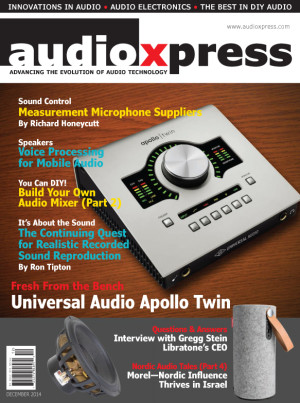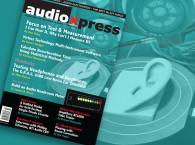
Our December cover highlight is a review of the Universal Audio Apollo Twin Thunderbolt-based audio interface. Oliver Masciarotte details how Universal Audio approached this design, leveraging the benefits of Thunderbolt technology and its own hardware-accelerated UAD Powered Plug-In architecture to implement a complete recording solution. The solution, based on the innovative Unison technology, basically offers true hardware emulation for the unit’s digitally controlled microphone preamps. In the review, the Apollo Twin is put to the test in real working environments and proves its worth with the help of Corning’s Thunderbolt Optical Cables.
Our December edition also features an interview with Gregg Stein, CEO of Libratone—one of the most innovative audio companies from Denmark—who explains how Libratone intends to leverage modern wireless technology to reinvent speakers for the 21st century. Libratone designs wireless speakers with organic wool skins and a different approach with sound dispersed in all directions, like an acoustic instrument. A Berklee College of Music (Boston, MA) graduate and professional musician, Gregg decided to study entrepreneurship and global management at Harvard University, allowing him to join Numark Industries and The Music Group (Behringer) and other companies, before becoming Libratone’s CEO for the Americas.
In the third part of our Standards Review column dedicated to Wireless Audio—Seeking Better Quality Wireless Audio Solutions—we examine Sonos and Apple’s AirPlay platforms and we continue our discussion of how Bluetooth and Wi-Fi technologies are powering wireless audio applications, particularly since Bluetooth V. 4.0 combined with the High-Speed (802.11) Protocol Adaptation Layer was introduced. The article details how Wi-Fi continues to evolve with more frequency bands, higher bit rates, and device-to-device communication, and how wireless audio technologies and development platforms are also quickly evolving to support higher quality audio transmissions.
Mike Klasco and Steve Tatarunis discuss audio technologies for Mobile Devices on their Speakers column, this month exploring the co-processors smartphones typically use to filter out wind noise and crowd babble, enhance voice intelligibility, and cancel acoustic echo, allowing us to communicate regardless of the environment.
Mike Klasco also continues to explore the history of Nordic speaker pioneers and brands and this time he discusses how loudspeaker influences from this northern European region appear in Israel-based Morel. As the article details, in 1979, Ejvind Skaaning from Scan-Speak entered a joint-venture with partners Gerhard Richter and Meir Mordechai to form RMS (which stood for Richter, Mordechai, and Skanning) in Israel, following Harman’s decision to close the company’s operations acquired from Ortofon. RMS would later become Morel and still resides at the original site. Skaaning and Richter went on to launch Dynaudio in Denmark, the topic of our next article in “Nordic Tales.”
Our Sound Control column focuses on Measurement Microphones and this month explores a dozen of the best-known measurement microphone suppliers. As Richard Honeycutt explains, “Measurement microphones are built to be the most accurate and reliable microphones available. Because of the high-quality demanded of these microphone types, manufacturers must use extremely high standards in the engineering of these devices.”
For a practical perspective, this month’s edition concludes George Adamidis’s “Build Your Own Audio Mixer” project. In the second part of this article, we will take the basic audio mixer and add circuits for audio equalization (EQ), a general graphic equalizer to perform general EQ at the output, a volume unit (VU) meter and a headphone monitor.
Gerhard Haas follows with an excellent perspective on Correct Tube Amplification for Headphones Operation and he explains the importance of voltage regulation on single-ended Class-A-type tube amplifiers with low power output used for operating headphones. Considering Ohm’s law and the datasheet specifications of the headphone manufacturers, his article intends to demonstrate what is really necessary.
Continuing with tubes, Richard Honeycutt’s Hollow-State Electronics column discusses Space-Charge Tubes, or specifically another way to build tube preamplifiers for low voltage operation using tubes specifically designed to operate with low plate voltages – normally designed for use in old automobile radios.
Your new issue of audioXpress is now available at www.gotomyxpress.com
To become a member, visit www.audioxpress.com/page/audioXpress-Subscription-Services.html.
You can also buy a single printed issue at /www.cc-webshop.com







